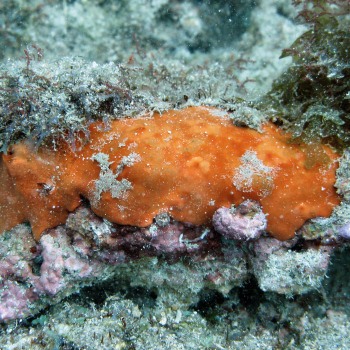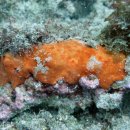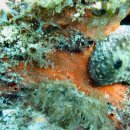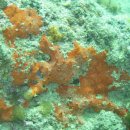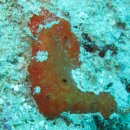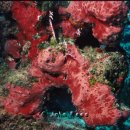| Common Name(s): |
Orange smooth encrusting sponge |
| Growth Form: |
Thickly encrusting, <1 cm thick, covering up to over a square meter of substrate. |
| Surface: |
Smooth. |
| Color: |
Bright orange in shallow water; red and pink, or red with white speckles around oscules on deep reefs. |
| Consistency: |
Tough, leathery. |
| Exudate: |
None. |
| Oscules: |
Oscules small, scattered, usually slightly elevated by a thin, rather transparent membrane the same color as the surrounding tissue or whitish. The ends of exhalant canals are often elevated near the oscules, forming a short star pattern. |
| Skeletal Components (Spicules, Fibers): |
Rods with 1 pointed end and 1 round swollen end (tylostyle). Microscleres are small, spiral, thickly spined rods (spiraster). No spongin fibers. |
| Skeletal Architecture: |
Erect tracts of tylostyles from the substrate to near the surface, with microscleres densely packed at the surface, and more loosely scattered throughout the rest of the body. |
| Ecology: |
On coral reefs and hard bottoms. |
| Distribution: |
South Florida and throughout the Caribbean. |
| Notes: |
Spirastrella hartmani Boury-Esnault et al. (1999) coexists with S. coccinea but is distinguished by its paler orange color and by the conspicuous network of thick exhalant canals that converge in oscules. Its spirasters have less robust spines than those of S. coccinea. Orange encrusting Pione lampa is a thin coat-of-paint, excavating encrustation on very shallow rocks and hard substrates just below low tide. |
| References: |
Duchassaing & Michelotti (1864), Boury-Esnault et al. (1999). |
| Similar species: |
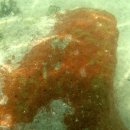
Pione lampa |
|
